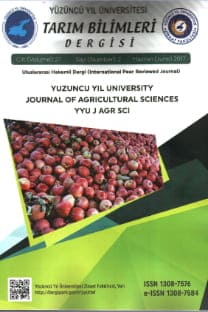Management of the hairy rose beetle, Tropinota squalida (Coleoptera: Scarabaeidae) by mass trapping in apple orchards
Management of the hairy rose beetle, Tropinota squalida (Coleoptera: Scarabaeidae) by mass trapping in apple orchards
___
- Al-Alawi MS (2014). Efficacy of essential oils from medicinal plants in control of the hairy rose beetle, Tropinata squalida (Scopoli) and their comparative toxicity to the honey bee, Apis mellifera L. Am. J. Agri. Biol. Sci.9 (3): 284-288.
- Ali MA (1993). Influence of trap colours and placement on captures of the hairy rose beetle, Tropinota squalida Scop. (Coleoptera, Scarabaeidae). Int. J. Trop. Insect Sci. 14: 215–219.
- Ateyyat MA, Al-Alawi MS. (2017). Flight Activity of the Hairy Rose Beetle, Tropinota squalida (Scopoli) in Apple and Cherry Orchards in Southern Jordan. Jordan J. of Boil. Sci. Vol. 10 (2): 95 – 99.
- El-Sayed AM, Suckling DM, Wearing CH, Byers JA (2006). Potential of Mass Trapping for Long-Term Pest Management and Eradication of Invasive Species. J. Econ. Entomol. 99: 1550-1564.
- Faccioli G, Pasqualini E, Baronio P (1993). Optimal trap density in Coses coses (Lepidoptera: Cossidae) masstrapping. J. Econ. Entomol. 86: 850 – 853.
- Faccoli M, Stergulc F (2008). Damage reduction and performance of mass trapping devices for forest protection against the spruce bark beetle, Ips typographus (Coleoptera Curculionidae Scolytinae). Ann. For. Sci. 65, 309.
- Hegazi E, Khafagi WE, Konstantopoulou M, Raptopoulos D, Tawfik H, Abd El-Aziz G M, Abd El-Rahman S M, Atwa A, Aggamy E, Showeil S (2009). Efficient Mass-Trapping Method As an Alternative Tactic for Suppressing Populations of Leopard Moth (Lepidoptera: Cossidae). Ann. Entomol. Soc. Am. 102: 809-818.
- Hussien H, Dimetry N, Zidan Z, Isshak R, Sehnal F (2005). Effects of insect growth regulators on the hairy rose beetle, Tropinota squalida (Col., Scarabeidae). J. App. Entomol. 129: 142-148.
- Knudsen JT, Tollsten L, Bergström LG (1993). Floral scents - a checklist of volatile compounds isolated by headspace techniques. Phytochem 33: 253-280.
- Madsen HF, Carty BE (1979). Codling moth (Lepidoptera: Olethreutidae) suppression by male removal with sex pheromone traps in three British Columbia orchards. Can. Entomol. 111: 627-630.
- Mafra Neto A, Habib M (1996). Evidence that mass trapping suppresses pink bollworm populations in cotton fields. Entomol. Exp. App. 81: 315-323
- SAS Institute (2002). SAS/STAT user’s guide, version 9. SAS Institute, Cary.
- Schmera D, Toth M, Subchev M, Sredkov I, Szarukan I, Jermy T, Szentesi A (2004). Importance of visual and chemical cues in the development of an attractant trap for Epicometis (Tropinota) hirta Poda (Coleoptera: Scarabaeidae). Crop. Prot. 23: 939–944.
- Smith JW (1998). Boll weevil eradication: area-wide pest management. Ann. Entomol. Soc. Am. 91: 239 – 247.
- Toth M, Schmera D, Imrei Z (2004). Optimization of a chemical attractant for Epicometis (Tropinota) hirta Poda. Z. Naturforsch C 59: 288–292
- Toth M, Vuts J, Difranco F, Tabilio R, Baric B, Razov J (2009). Detection and Monitoring of Epicometis hirta Poda and Tropinota squalida Scop. with the Same Trap. Acta Phytopathol. Entomol. Hung. 44: 337–344.
- Wilde GE, Whitworth RJ, Shufran RA, Zhu KY, Sloderbeck PE, Higgins RA, Buschman LL (1998). Rootworm area wide management project in Kansas. J. Agr. Entomol. 15: 335 - 349
- Zhang GF, Meng XZ, Han Y, Sheng CF (2002). Chinese tortrix Cydia trasias (Lepidoptera: Olethreutidae): suppression on street-planting trees by mass trapping with sex pheromone traps. Environ. Entomol. 31: 602- 607.
- ISSN: 1308-7576
- Yayın Aralığı: 4
- Başlangıç: 1991
- Yayıncı: Yüzüncü Yıl Üniversitesi Ziraat Fakültesi
The Dripline Uniformity in The Irrigation with Different Reclaimed Wastewaters
Hayriye Yıldız DAŞGAN, Sultan DERE, Yelderem AKHOUNDNEJAD, Nesibe Ebru KAFKAS
Ertan YILDIRIM, Atilla DURSUN, Metin TURAN, Melek EKİNCİ, Fazilet PARLAKOVA KARAGÖZ, Raziye KUL, Zeynep GÖK
Rahim GHARESHEIKHBAYAT, Eissa ZARIFI
Effect of Preharvest Applications on Storage and Quality Properties of Miho Wase Mandarin
Burcu DÜNDAR, Ömür DÜNDAR, Okan ÖZKAYA, Emre KÜKÜRT, Hatice DEMİRCİOĞLU, Oğuzhan EROĞLU
Mehmet Salih ÖZGÖKÇE, Esra KINA, Hilmi KARA
Biberiye (Rosmarinus Officinalis) Bitkisinin Fitoremediasyon Amaçlı Kullanım Potansiyeli
Hasan KILIÇ, Nurcan KÖLELİ, Abdullah EREN
Gamze SANER, Sule AZAK, Yaşar Tevfik TUZUN
Rumaisha ISHTIAQ, Sadam MUNAWAR, Muhammad Nisar ANJUM, Faiz Ahmad JOYIA, Ghulam MUSTAFA, Muhammad Amjad ALI, Muhammad Sarwar KHAN
